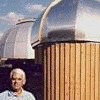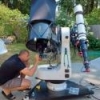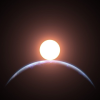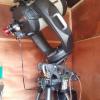Yes, I am serious... Some heavy DIY involved and a but of glue and cutting and more glue and cutting, but something with a lot of gain, very low noise and cheap.
More suited to fitting a permanent lens of fairly short magnification ( eg, under 200mm ) and using for locating objects, for which it is excellent, but if you're really dedicated and a glutton for punishment, you could attach it to any telescope.
Now, before anyone gets too excited, there are some caveats.
1. It weighs about 2Kg.
2. It's about the size of a pringles can.
3. It has some serious "fisheye" distortion.
4. It involves older, surplus tubes.
5. You can connect a video camera if you like. Heck, it already weighs 2Kg - you could attach a Betacam if you like.
6. It's a beginner level project. If you can tie your shoelaces but only barely, it's not for you. If you can cut straight, use sharp tools and color within the lines, it should be doable.
7. It involves PVC plastic and black plastic paint.
8. It will look ugly, but it will compare to older Gen3 tube technology even though it's actually Gen1 technology. ( Called "Cascade" or "Multi-stage" or "Starlight" technology.
9. You can make a terrestrial project out of it. They work well down to starlight levels without any extra IR.
10. You will have to find the parts. I can only provide guidance. But I've seen someone make one with duct-tape and cardboard as the main components.
If anyone is interested, let me know. A fun project and great for spotting satellites, meteors, comets, alien motherships or anything else that comes close to the earth but is a little difficult to see.
And before I get too far into it, you can see details of previous projects here: http://aunv.blackice...s&story=cascade
But I will be straight up and say "I have never made one of these for an eyepiece adapter before and it may not be very pretty... But it should work OK."
Anyway, this first post is to gauge interest. If anyone is interested, I'd be happy to make it a group project. It's still fun even as an example to how to make your own kit and you can always buy some cheap Gen2 or Gen3 tubes to make your own eyepiece using the same technology.
Even that probably won't be pretty, but if you're in for the ride, let me know
But if the interest is eyepieces and the weight doesn't make you burst out in laughter, I'll go through the motions there too and talk you through everything you wanted to know.
The fun comes with a lesson in how intensifiers work and everyone is welcome to watch who doesn't join in. Just so it's known upfront, I don't get anything out of this except enjoyment - so I don't sell the parts or make any component of it.
Regards
David























